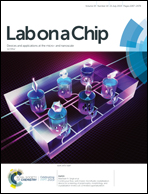Measurement of the magnetic susceptibility of subtle paramagnetic solutions using the diamagnetic repulsion of polymer microparticles†
Abstract
Herein, we described a microfluidic device that enabled the measurement of magnetic susceptibility of a subtle paramagnetic solution that could not be determined by conventional magnetic susceptibility measurement methods such as a superconducting quantum interference device (SQUID). We measured the diamagnetic repelling velocity of polystyrene microparticles suspended in a weak paramagnetic solution including 50–150 mM of gadolinium–diethylenetriamine penta-acetic acid (GD-DTPA) and superparamagnetic iron oxide nanoparticles (SPION) (10 nm in diameter) dispersed in distilled water at various concentrations. The measured diamagnetic repelling velocities correlated with our prediction and also with the magnetic susceptibility of the SPION solution measured by a SQUID magnetometer. Via this approach, we could determine the magnetic susceptibility of the subtle paramagnetic solution of GD-DTPA that could not be measured via the conventional method. This study provides us with the new capability of analyzing weakly paramagnetic solutions such as paramagnetic components or metal contaminants present in environmental liquid samples at low concentrations.

- This article is part of the themed collections: Lab on a Chip Emerging Investigators and Lab on a Chip Recent HOT Articles


 Please wait while we load your content...
Please wait while we load your content...